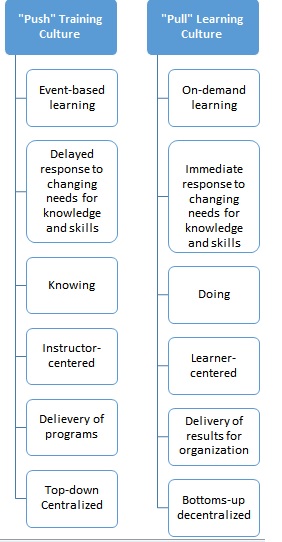The major change in business today is the rate of change…. the time between conception of an idea and market acceptance was five to seven years. Now a new car model goes from idea to market in 24 months. “Internet time” is just a few months for most things. My public offerings…used to take months or years. Now, crowdfunding can raise millions of dollars for a new business in a few weeks.
John Psarouthakis
As the digital revolution continues rapidly increasing the rate of change andtransforming all aspects of business, from supply chain management to communicationthe highest-performing corporations are abandoning traditional “push” training for the “pull” learning model.
Push training is a centralized, top-down model that occurs when management determines what it is people need to know or do and “pushe”’ educational programs out from a central training group. Going to a class or taking an assigned online program is push training.
In a push training model, learning is test-based. It is all about what you know.
The problem is that the push training culture was developed to serve the old Industrial Economy that no longer exists.
It is a relic from the time when producing products and delivering services changed slowly and the shelf-life of both was almost glacial compared to today’s reality. In the pre-digital age, most workers did not need to learn volumes of information to perform their jobs. We all know that has changed.
So why is it that, despite the change from the Industrial to the Knowledge Economy over 100 years ago, the vast majority of organizations still push training out to employees in almost the same ways as they did then?
We are hard-pressed to think of any other business function that is still managed as it was a century ago. Especially when the research clearly shows that push training is an inefficient way of developing skills, abilities and attitudes. Studies show that push training programs only managed in transferr a mere 10 to 20 percent of skills to the workplace. This is a huge waste of 80 to 90 percent of the investment in those programs.
“Pull learning” is the model for the new Knowledge Economy.
It is a decentralized, bottom-up approach that enables employees to access the information they need right when it is needed. Employees are connected and able to collaborate tomake the best use of the supporting technology which connects them to each another and to the sources of information.
Imagine employees facing a new situation in which they require more instruction. With pull training, employees can quickly and easily locate and access the most current information in a variety of ways, when and where they need it.
In a pull model learning is performance-based. The focus is on what you can do when you need to get it done.
Figure 1: Push or Pull
Replacing Push with Pull: The Learning Culture
Replacing push training with pull learning transforms an organization into a learning culture.
A learning culture is an organization that can provide relevant, useable and on-demand access to the knowledge and skills employees need to perform their jobs. This includes technical, operational, and managerial skills. Our research over the past two years shows that corporations that commitment to becoming a learning culture experience measurable, significant and sustainable increases in on-the-job performance, talent-retention, sales revenue, and innovation.
Our research and consulting with leading corporations has further convinced us that the smartest, highest performing, most successful organizations in the current global idea-based economy are learning cultures. Why? Because they are more agille –able to respond instantly to the ever-changing requirements and demands of a fast-paced, hyper-competitive marketplace. Their employees can quickly access the technology and support to find what they need to know, when and where it is needed. Shifting from training and knowing to learning and doing improves the thousands of job-related actions and decisions performed each day, and makes mission-critical corporate-level decisions more immediate and effective.
Yet surprisingly few organizations and their leaders have fully grasped the enormous benefits to be realized by becoming a learning culture. It has become obvious to us that a fundamental shift needs to occur in the way senior managers think about how they provide knowledge and know-how to their workforce.
It is time to stop seeing the workplace as a relatively static 9-5 schoolplace where employees receive an occasional invitation to a training event. Leaders need to reimagine the workplace as a constantly moving beehive in which employees are continuously learning whatever knowledge and skills will help them do their jobs more effectivley.
If you would like more information about what it takes to transform your company into a high-performing learning culture, contact Stephen at sjgill@learningtobegreat.com or David at david@knowledgestar.com


I really like this concept, David. ‘Pull’ means to me ‘customized, personalized’ while ‘push’ means imposed. Maybe the first one is a bigger challenge for companies and the second is something they are used to do from ages. Anyway there’s this ‘customize everything’ trend and I think it’ll be applied to Learning Culture eventually.
LikeLike